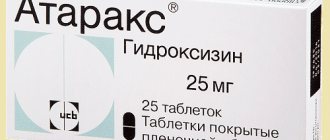Atarax for anxiety disorders (review)
Ryabokon I.V.
Anxiety is a state of fear and anxiety experienced by a person in anticipation of trouble. The causes of anxiety are varied: emotional instability, a sharp change in living conditions, the upcoming completion of a difficult task, etc. Anxiety may arise due to anticipation of a future threat (punishment or loss of loved ones). Typically, anxiety leads to defensive reactions. Anxiety is the result of frustration or its anticipation and is the primary psychological manifestation of stress. Z. Freud considered anxiety as a symptomatic manifestation of an internal emotional conflict caused by the fact that a person unconsciously suppresses sensations, feelings or impulses that are too threatening or irritating for him. With the emergence of anxiety, behavioral activity increases, the very nature of behavior changes, and additional physiological mechanisms of adaptation to changed conditions are activated.
Anxiety is a person’s tendency to experience a state of anxiety. Most often, a person’s anxiety is associated with the expectation of social consequences of his success or failure. Anxiety and anxiety are closely related to stress. On the one hand, anxious emotions are symptoms of stress. On the other hand, the initial level of anxiety determines individual sensitivity to stress. Like stress in general, the state of anxiety cannot be called unequivocally bad or good.
Sometimes anxiety is natural, adequate, and useful. Everyone feels anxious, restless or stressed in certain situations, especially if they have to do something unusual or prepare for it. For example, giving a speech in front of an audience or passing an exam. A person may feel anxious when walking down an unlit street at night or when lost in a strange city. This type of anxiety is normal and even useful, as it prompts you to prepare a speech, study the material before an exam, and think about whether you really need to go out at night all alone.
In other cases, anxiety is unnatural, pathological, inadequate, harmful. It becomes chronic, constant and begins to appear not only in stressful situations, but also for no apparent reason. Then anxiety not only does not help the person, but, on the contrary, begins to interfere with him in his daily activities.
The line between a “normal” stress response and a pathological anxiety disorder is often quite blurred, and it is difficult for a person to know when to seek professional help. These subsyndromal anxiety disorders are the most difficult to diagnose and often remain untreated, while having an extremely negative impact on the quality of life of the patient and those around him. It is believed that treatment options should be considered when anxiety about everyday events is beyond the patient's control. The following disorders may also be the reason for prescribing therapy: nervousness, fussiness, impaired concentration, irritability, sleep disturbance, symptoms of autonomic dysfunction.
In everyday medical practice, various herbal medicines, tranquilizers, barbiturates, antidepressants, and some antipsychotics are used to treat anxiety disorders.
One of the most powerful and quickly relieving sleep disorders and anxiety are benzodiazepine drugs. Among the disadvantages of treatment with benzodiazepines, the following should be mentioned: withdrawal syndrome (rapid resumption or transient increase in symptoms after discontinuation of the drug), the risk of addiction and the formation of drug dependence, impaired cognitive functions (attention, concentration, memory), and impaired coordination. Therefore, benzodiazepine drugs are not recommended to be taken for more than 2 weeks.
Hydroxyzine (Atarax) is neither a benzodiazepine nor a phenothiazine. The non-benzodiazepine anxiolytic Atarax (hydroxyzine) is a derivative of diphenylmetane, an antagonist of histamine H1 receptors.
Hydroxyzine is one of the oldest psychotropic drugs; it was introduced into clinical practice back in 1955. Atarax has a pronounced anti-anxiety, antihistamine, antipruritic and antiemetic effect. By reducing the concentration of histamine at the central level, it has the property of reducing anxiety, reducing aggressiveness and causing a persistent anxiolytic effect [2]. The drug acts within 15–30 minutes after oral administration (Cmax is noted 2 hours after taking the drug) and maintains this effect for 6–8 hours. Its main advantages are the absence of the “rebound” phenomenon, addiction (dependence), withdrawal symptoms and positive effect on cognitive function.
Hydroxyzine has been successfully used in a variety of areas of medicine: as a means of controlling tobacco smoking [3]; in pediatric dentistry [4]; for its intended purpose – for the treatment of anxiety neurosis (even in the era of the existence of such a nosological form) and for “mild” depression [5]; for behavioral and learning disorders in children [6]. Due to its antihistamine properties, hydroxyzine was used in allergology, to treat itching [7], and for urticaria pigmentosa (mastocytosis) in children [8]; in oncology [9]; in burn patients [10], in narcology [11] and in many other conditions.
Recently, there has been interest among researchers in the use of hydroxyzine in patients with generalized anxiety disorder (GAD). The prevalence of this pathology and the associated burden of social consequences in the current scientific literature appear to be quite significant. According to one review [E.G. Starostina. Generalized anxiety disorder and anxiety symptoms in general medical practice. Rus. honey. magazine 2004; 22 (222), 12: 1277] with reference to numerous foreign works, “GAD is among the top ten diseases with the greatest temporary disability and according to this indicator is on a par with coronary artery disease, diabetes, joint diseases, peptic ulcers, and mental disorders – with depression or even ahead of it.”
In a double-blind, placebo-controlled RCT for the treatment of GAD [17], the anxiolytic activity of Atarax at a dose of 50 mg (in 3 doses of 12.5 mg in the morning and afternoon plus 25 mg in the evening) was shown, which was manifested in a statistically significant, rapid and significant decrease symptoms of anxiety already at the end of the 1st week of treatment, which persisted for another 1 week after cessation of treatment (n=110; course duration 4 weeks; Hamilton-A score). In this case, there was no phenomenon of “rebound” or return of anxiety.
In another double-blind multicenter RCT [18], in which, along with placebo control, the benzodiazepine drug bromazepam was also used, it was shown that hydroxyzine used for 3 months was statistically significantly different from placebo and was as effective as the comparison drug. Moreover, with benzodiazepine, side effects of severe drowsiness were observed twice as often as with hydroxyzine (n = 334; dose of hydroxyzine 50 mg/day in 3 divided doses; bromazepam - 6 mg/day in 3 divided doses; improvement on the Hamilton-A scale >50 %; p<0.03 at the end of the 6th week and p<0.001 - after 12 weeks; the number of patients who responded to treatment: 40% at the 6th and 60% at the 12th week, respectively).
Another study [19] showed the effectiveness of Atarax (50 mg in 3 doses), comparable to that of the control buspirone (20 mg in 3 doses), with a statistically significant difference between Atarax and placebo on the 28th day of treatment (p<0.015) . There was no rebound phenomenon with abrupt withdrawal of both drugs (n=244; age 18–65 years).
In addition, one of the advantages of hydroxyzine is that, unlike benzodiazepines, it does not depress cognitive abilities [20] (triple crossover, double-blind RCT; comparing a single dose of 50 mg of hydroxyzine with a single dose of 2 mg of lorazepam and placebo; n = 9; healthy volunteers; 3-day interval before cross-over; assessment of cognitive functions 2–5 hours after taking comparator drugs).
Some studies have shown a positive effect of hydroxyzine on cognitive function [21] (comparison with lorazepam; double-blind multicenter RCT; n=30; GAD, Atarax 100 mg in 3 divided doses, lorazepam 4 mg in 3 divided doses; Beck score 28– th day of treatment). Unlike lorazepam, with the same anxiolytic activity, hydroxyzine restored cognitive function to normal limits.
Similar results were obtained in another, less conclusive study - an open RCT (A.E. Bobrov et al. Journal of Neurology and Psychiatry named after S.S. Korsakov. 1988; 2. GAD; n=50; outpatients; treatment course is 4 weeks, plus 2 weeks of follow-up).
Considering the characteristics of the drug (quick onset of action, good tolerability), lack of dependence and depression of the central nervous system make it an alternative drug to benzodiazepines in children and adolescents. In a study conducted at the Children's Psychiatry Center [23], Atarax was prescribed for various forms of mental illness in children and adolescents with manifestations of anxiety, irritability and insomnia-type sleep disorders, and its effectiveness was assessed. The study included 50 patients aged 5 to 18 years with various forms of mental illness, who were undergoing outpatient observation and treatment at the Children's Psychiatry Center. At the end of the 4th week of therapy, there was a decrease in the manifestations of anxiety and various fears noted earlier: falling asleep in the dark, staying at home in the absence of parents, fears of animals, noise of household appliances; in one case, a five-year-old boy could stay at home with a nanny without his parents (he had previously shown a pronounced affective reaction). In addition, all patients' sleep improved already in the second week of therapy, tearfulness, moodiness, and irritability were reduced. Simultaneously with the reduction of anxiety, the mood improved in 7 patients with a mixed anxious and depressive reaction caused by an adaptation disorder and with a mixed anxiety and depressive disorder, which was associated not with the direct antidepressant effect of Atarax, but with the comorbid dependence of anxiety and depression: anxiety was reduced - depression went away.
In a comparative study [22] of etifoxine and Atarax (hydroxyzine), the compared anxiolytics demonstrated high effectiveness in a wide range of psychopathological manifestations of adjustment disorders and generalized anxiety disorder. The results of therapy with etifoxine and Atarax showed the comparability of the clinical effect of the compared drugs, confirmed by a number of formalized indicators. The proportions of responders were comparable: 73.3 and 53.3% in the HARS assessment; 66.7 and 53.3% - as assessed by CGI-S for the groups receiving etifoxine and Atarax. The main clinical effect of the drugs in both groups was a decrease in the severity of manifestations of mental anxiety: the symptoms of internal tension (ethifoxine - in the 2nd week, Atarax - in the 3rd week), reactive (emotional) lability (one of the sub-items of “depressive mood”) were most quickly reduced "). In general, similar dynamics of cognitive anxiety were observed in both groups.
To summarize, we can reiterate that hydroxyzine (Atarax) has shown clear advantages over benzodiazepine anxiolytics in the treatment of anxiety disorders. Being as therapeutically effective as benzodiazepine anxiolytics, it does not produce rebound effects, does not depress cognitive function, and does not cause pathological dependence.
Literature:
1. Psychotropics 2000/2001 Lundbeck.
2. Krebs MO. Le trouble anxieux: cliniqu et implicacion neurobiologiques. La Revfue des Entretiens de Bichat 2001; 2 (5).
3. Turle G. An investigation into the therapeutic action of hydroxyzine/Atarax in the treatment of nervous disorders and the control of tobacco-habit. Brit J Psychiat 1958; 104: 82 rub. 33.
4. Lang L. An evaluation of the efficacy of hydroxyzine (atarax–vistaril) in controlling the behavior of child patients. J-Dent-Child 1965; 32, 4: 253–8)
5. R.Middlefell, K.Edwards Hydroxyzine/Atarax in the relief of tension associated with anxiety neurosis and mild depressive states. Brit J Psychiat 1959; 105:792–4.
6. Segal L, Tansley A. A clinical trial with Hydroxyzine (Atarax) on a group of maladjusted educationally subnormal children. J Mental–Science; Br J Psychiat from 1963; 1957; 103:677–81.
7. Rhoades R, Leifer K, Cohan R, Wittig H. Suppression of histamine-induced pruritus by three antihistaminic drugs. J Allergy Clin Immunol, 1975 Mar.; 55, 3: 180–5.
8. Kettelhut B, Berkebile C, Bradley D, Metcalfe D. A double-blind, placebo-controlled, crossover trial of ketotifen versus hydroxyzine in the treatment of pediatric mastocytosis. J Allergy Clin Immunol 1989 May; 83, 5: 866–70)
9. Broder L, Lean N, Hilsenbeck S. A randomized blinded clinical trial comparing delta–9–tetrahydrocannabinol (THC) and hydroxizine (HZ) as antiemetics (AE) for cancer chemotherapy (CT). PROC–AM–ASSOC–CANCER–RES; 1982; 23:514.
10. Vitale M, Fields–Blache C, Luterman. A Severe itching in the patient with burns. J burn care & rehabilitation 1991; 12, 4: 330–3.
11. Kaim S, Klett C, B. Rothfeld. Treatment of the acute alcohol withdrawal state: a comparison of four drugs. Agressologie: revue internationale de physio-biologie et de pharmacologie appliquees aux effets de l'agression, 1968; 9, 2: 305–8.
12. Chignon G. Le trouble Anxiete Generalise: du probleme diagnostique au defi therapeutique. Nervure J psychiat 1988; 11 (suppl.): 1–16.
13. Wittchen H–U, Jakobi F. Size and burden of mental disorders in Europe – a critical review and appraisal of 27 studies. Eur Neuropsychopharmacol 2005; 15: 357–76; For details, see the February issue of our magazine).
14. Goodwin R, Gorman J. Psychopharmakologic Treatment of generalized anxiety disorder and risk of major Depression. Am J Psychiat 2002; 159:1935–7.
15. Goodwin RD, Jack M. Gorman. Treatment of generalized anxiety disorder with psychotropic drugs and the risk of major depressive disorder
16. Martin P. Coprescription, Antidepresseurs et anxiolytiques: consequences pratiques de la meilleure connaissance desmecanismes d'action putatifs des anxiolytiques. Actuel Psychiat 2001; 19 (1/2): 2–7.
17. Ferreri M, Hantouche T, M. Billardon. Interet de l'hydroxizyne dans des troubles d'anxiete generalisee: etude controlee en double aveugle versus placebo. L'encephale 1994; 20: 785–91.
18. Llorka P. et al. Efficiency and safety of hydroxysyne in the treatment of generalized anxiety disorder: a 3-month double-blind study. J Clin Psychiatry 2002; 63:1020–7.
19. Lader Scotto J. A multicenter double–blind comparison of hydroxizine, buspirone and placebo in patient with generalized anxiety disorder. Psychopharmacology 1998; 139:402–6.
20. De Brabander A, Deberdt W. Effect of hydroxizyne on attention and memory. Human Psychopharmacology 1990; 357–62.
21. Samuelian J, Billardon M, Guillou N. Retentissment sur les functions cognitives de deux traits anxiolitiques chez des patients souffrant d'anxiete generalisee. L'encephale 1995; 21:147
22. Andryushchenko A.V., Beskova D.A., Romanov D.V. Psychopharmacotherapy of generalized anxiety (experience with the use of Strezam and Atarax) Mental disorders in general medicine No. 1; pp. 33–36
23. Rezakov A.A. Experience of using hydroxyzine (atarax) in children and adolescents. "PHARMIndex-Practik" issue 10; 2006, pp.37–39
Side effects
VSD is a neurosis or a psychological problem, which means that the causes of this problem cannot be removed with medication.
Yes, medications temporarily relieve the annoying symptoms of aggravated dystonia, but if treatment is canceled, everything will return to normal - this truth is known to every VSD sufferer. And yet a person needs to live somehow, do household chores, go to work and at least sometimes get enough sleep. No one will do this for us. Therefore, at some periods of life, medications are extremely necessary. And the treatment of the soul, as a rule, is constantly postponed until later. Atarax helps with VSD and panic attacks, gives mental and physical strength to live on, but you should remember: timely contact with an experienced psychotherapist is sometimes the only chance to overcome neurosis. Moreover, any medications that change our mood and brain functions always have side effects. Even if the patient has no contraindications to taking the drug, the body’s reaction may be unpredictable. Most often, side effects occur when the specified dosage is violated or when Atarax is taken simultaneously with incompatible medications and alcohol. These include:
- nausea and vomiting;
- dry mucous membranes;
- stool disorders;
- headache;
- body chills;
- loss of coordination;
- profuse sweat;
- a sharp decrease in blood pressure;
- lethargy and lethargy.
- drowsiness.
The described side effects are not considered fatal and go away after some time. In general, the main side effects of atarax are lethargy, drowsiness and lethargy. As a rule, this effect disappears after 1-2 weeks of taking the drug. An important advantage of atarax is that it is not addictive and has no withdrawal symptoms.




